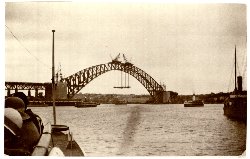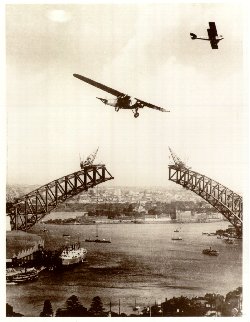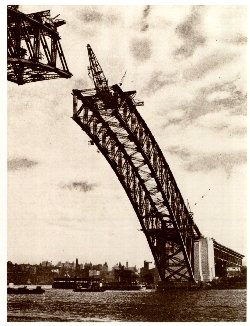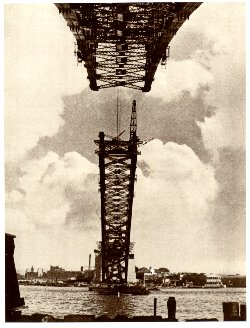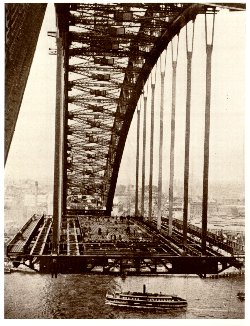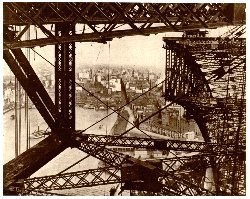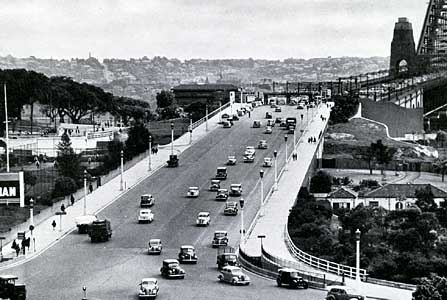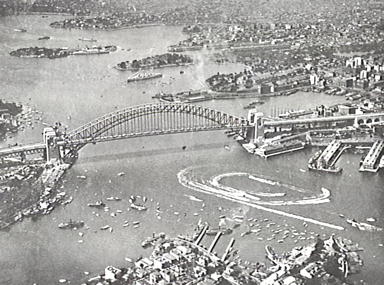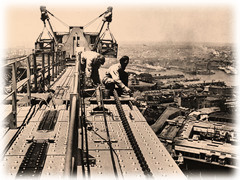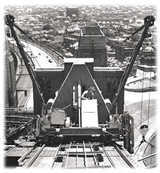Sydney Harbour Bridge is the world's
largest (but not longest as thats the New River
Gorge in the USA) steel arch
bridge, and, in its beautiful harbour location, has become a renowned international
symbol of Australia.
Its total length including approach spans is 1149 metres and its arch span is 503 metres. The
top of the arch is 134 metres above sea level and the clearance for shipping under the
deck is a spacious 49 metres. The total steelwork weighs 52,800 tonnes, including 39,000
tonnes in the arch. The 49 metre wide deck makes Sydney Harbour Bridge the widest Longspan
Bridge in the world.
 |
It now carries eight vehicle lanes, two train lines, a footway and a cycleway.
After inviting worldwide tenders in 1922, the New South Wales Government received twenty
proposals from six companies and on 24 March 1924; the contract (for
Australian 4,217,721 pounds 11 shillings and 10 pence!) was let to the English firm Dorman
Long and Co of Middlesbrough.
The general design was prepared by Dr J.J.C Bradfield and officers of the NSW Department
of Public Works, while the detailed design and crucial erection process were undertaken by
the contractors consulting engineer Mr (later Sir) Ralph Freeman of Sir Douglas Fox and
Partners and his associate Mr. G.C Imbault. Some other designs that where
not choosen can be found here. |
As Chief Engineer of Sydney Harbour Bridge and Metropolitan Railway Construction from
1912, Dr Bradfield is regarded as the "father" of the Bridge as it was his
vision, enthusiasm, engineering expertise and detailed supervision of all aspects of
its construction which brought Sydney's long held dream into reality.
The contractors, under Director of Construction, Lawrence Ennis, set up two workshops at
Milsons Point on the North Shore. Here, the steel (79% imported from
England, 21% from Australian sources) was fabricated into girders etc.
The foundations for the four main bearings, which carry the full weight of the main span
were dug to a depth of 12.2 metres and filled with special reinforced high-grade concrete
laid in hexagonal formations.
The four impressive, decorative 89 metre high pylons are made of concrete, faced with
granite, quarried near Moruya, where about 250 Australian, Scottish and Italian
stonemasons and their families lived in a temporary settlement. Three ships were
specifically built to carry the 18,000 cubic metres of cut, dressed and numbered granite
blocks, 300km north to Sydney.
After the approach spans were erected, work began on the main arch. Two half-arches were
built out progressively from each shore, each held back by 128 cables
anchored underground through U-shaped tunnels. Steel members were fabricated in the workshops, placed onto
barges, towed into position on the harbour and lifted up by two 580 tonne electrically
operated creeper cranes, which erected the half-arches before them as they travelled
forward.
There was great excitement on 20 August 1930 after the arch was successfully joined at
10pm the night before. The steel decking was then hung from the arch and was all in place
within nine months, being built from the centre outwards to save time moving the cranes.
As the project neared completion, the last of approximately six million Australian made
rivets were driven through the deck on 21 January 1932. In February 1932 the Bridge was
test loaded using up to 96 steam locomotives placed in various
configurations.
The official opening day on Saturday 19 March 1932 was a momentous occasion, drawing
remarkable crowds (estimated between 300,000 and one million people) to
the city and around the harbour foreshores. The NSW Premier, the Hon. John T.
Lang, officially declared the Bridge open. However, the Premier enlivened
proceedings when Captain Francis De Groot of the para-military group, the New
Guard, slashed the ribbon prematurely with his sword, prior to the official cutting.
This incident caused both amusement and dismay on the day and has since become part of
Australian folklore.
The opening celebrations included a vast cavalcade of decorated floats, marching groups
and bands proceeding through the city streets and across the deck in a pageant of
surprising size and quality, considering the economic depression.
The celebrations continued with a gun-salute, a procession of passenger ships under the
Bridge, a "venetian" carnival, a fly-past, fireworks, sports carnivals and exhibitions.
After the pageant the public was allowed to walk across the deck.. an event not
repeated until the 50th anniversary of the Bridge in 1982. |
 |
Some enthusiastic ones celebrated by unofficially
climbing up the arch.
The Harbour Bridge is an essential artery feeding traffic to and from
Sydney. Below our traffic statistics and facts and figures.
Below some more ancient pictures that where taken a long
time ago 'probably' during the
construction. I got these pictures from someone else
who scanned them in for me. Thanks mate..
If someone else has other nice pictures please let me know so the collection
can be further increased.
|









